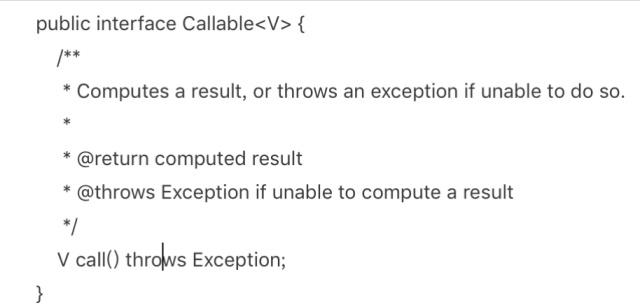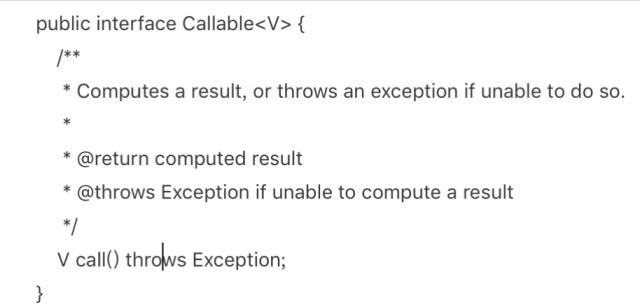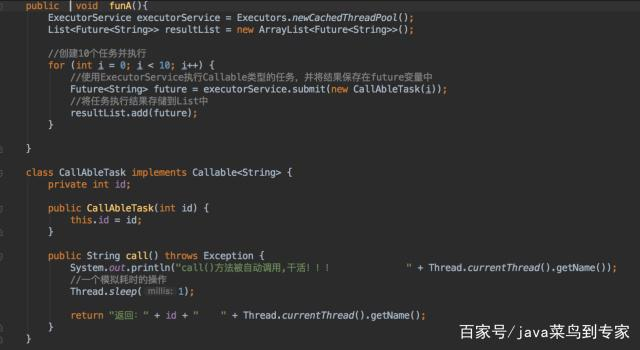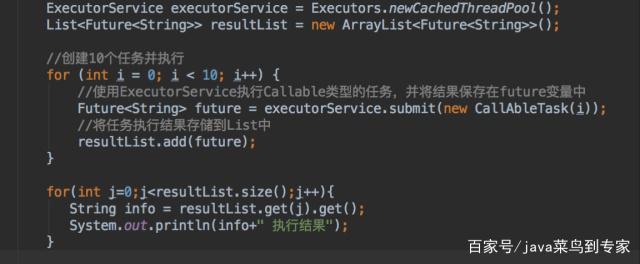Java多线程实现方式主要有三种:继承Thread类、实现Runnable接 口、使用ExecutorService、Callable 实现有返回结果的多线程。其中前两种方式线程执行完后都没有返回值,只有最后一种Callable是带返回值的,返回结果可以从Future中取出来
关于ExecutorService 参考:Java-线程池专题 (美团)
1、继承Thread类实现多线程
继承Thread类的方法尽管被我列为一种多线程实现方式,但Thread本质上也是实现了Runnable接口的一个实例,它代表一个线程的实例,并且,启动线程的唯一方法就是通过Thread类的start()实例方法。start()方法是一个native方法,它将启动一个新线程,并执行run()方法。这种方式实现多线程很简单,通过自己的类直接extend Thread,并复写run()方法,就可以启动新线程并执行自己定义的run()方法。例如:
public class MyThread extendsThread {public voidrun() {
System.out.println("MyThread.run()");
}
}
在合适的地方启动线程如下:
MyThread myThread1 = newMyThread();
MyThread myThread2= newMyThread();
myThread1.start();
myThread2.start();
2、实现Runnable接口方式实现多线程
如果自己的类已经extends另一个类,就无法直接extends Thread,此时,必须实现一个Runnable接口,如下:
public class MyThread extends OtherClass implementsRunnable {public voidrun() {
System.out.println("MyThread.run()");
}
}
为了启动MyThread,需要首先实例化一个Thread,并传入自己的MyThread实例:
MyThread myThread = newMyThread();
Thread thread= newThread(myThread);
thread.start();
事实上,当传入一个Runnable target参数给Thread后,Thread的run()方法就会调用target.run(),参考JDK源代码:
public voidrun() {if (target != null) {
target.run();
}
}
3、使用ExecutorService、Callable 实现有返回结果的多线程
ExecutorService、Callable 这个对象实际上都是属于Executor框架中的功能类。想要详细了解Executor框架的可以访问 主题:java并发编程-Executor框架,这里面对该框架做了很详细的解释。返回结果的线程是在JDK1.5中引入的新特征,确实很实用,有了这种特征我就不需要再为了得到返回值而大费周折了,而且即便实现了也可能漏洞百出。
可返回值的任务必须实现Callable接口,类似的,无返回值的任务必须Runnable接口。执行Callable任务后,可以获取一个Future的对象,在该对象上调用get就可以获取到Callable任务返回的Object了,再结合线程池接口ExecutorService就可以实现传说中有返回结果的多线程了。下面提供了一个完整的有返回结果的多线程测试例子,在JDK1.5下验证过没问题可以直接使用。代码如下:
import java.util.concurrent.*;importjava.util.Date;importjava.util.List;importjava.util.ArrayList;/*** 有返回值的线程*/@SuppressWarnings("unchecked")public classTest {public static void main(String[] args) throwsExecutionException,
InterruptedException {
System.out.println("----程序开始运行----");
Date date1= newDate();int taskSize = 5;//创建一个线程池
ExecutorService pool =Executors.newFixedThreadPool(taskSize);//创建多个有返回值的任务
List list = new ArrayList();for (int i = 0; i < taskSize; i++) {
Callable c= new MyCallable(i + " ");//执行任务并获取Future对象
Future f =pool.submit(c);//System.out.println(">>>" + f.get().toString());
list.add(f);
}//关闭线程池
pool.shutdown();//获取所有并发任务的运行结果
for(Future f : list) {//从Future对象上获取任务的返回值,并输出到控制台
System.out.println(">>>" +f.get().toString());
}
Date date2= newDate();
System.out.println("----程序结束运行----,程序运行时间【"
+ (date2.getTime() - date1.getTime()) + "毫秒】");
}
}class MyCallable implements Callable{privateString taskNum;
MyCallable(String taskNum) {this.taskNum =taskNum;
}public Object call() throwsException {
System.out.println(">>>" + taskNum + "任务启动");
Date dateTmp1= newDate();
Thread.sleep(1000);
Date dateTmp2= newDate();long time = dateTmp2.getTime() -dateTmp1.getTime();
System.out.println(">>>" + taskNum + "任务终止");return taskNum + "任务返回运行结果,当前任务时间【" + time + "毫秒】";
}
}
代码说明:
上述代码中Executors类,提供了一系列工厂方法用于创先线程池,返回的线程池都实现了ExecutorService接口。
public static ExecutorService newFixedThreadPool(int nThreads)
创建固定数目线程的线程池。
public static ExecutorService newCachedThreadPool()
创建一个可缓存的线程池,调用execute 将重用以前构造的线程(如果线程可用)。如果现有线程没有可用的,则创建一个新线程并添加到池中。终止并从缓存中移除那些已有 60 秒钟未被使用的线程。
public static ExecutorService newSingleThreadExecutor()
创建一个单线程化的Executor。
public static ScheduledExecutorService newScheduledThreadPool(int corePoolSize)
创建一个支持定时及周期性的任务执行的线程池,多数情况下可用来替代Timer类。
ExecutoreService提供了submit()方法,传递一个Callable,或Runnable,返回Future。如果Executor后台线程池还没有完成Callable的计算,这调用返回Future对象的get()方法,会阻塞直到计算完成。
具体 ExecutorService的使用 参考:Java-线程池专题 (美团)
二、Thread 和Runnable 的区别和联系
如果研究一下源码就会发现:Thread其实本身就是实现了接口 Runnable的一个类;
因此 Thread中的方法和成员变量要比Runnable多,最典型地就是 Thread有start()方法,但是Runnable接口没有start()方法;
如果想要执行一段线程:
public threadTest extendsThread {...
@Overridepublic voidrun() {..}
}
threadTest th1=new threadTest("一号窗口");
th1.start();
这里 继承了Thread类,并且重写了方法run();
然后调用 此类的start()方法来执行,记住不是调用run()方法执行 ,而是start(),因为:
1.run()并不是启动线程,而是简单的方法调用。
2.并不是一启动线程(调用start()方法)就执行这个线程,而是进入就绪状态,什么时候运行要看CPU。
区别
实际开发中我们通常采用Runnable接口来实现多线程。因为实现Runnable接口比继承Thread类有如下好处:
1. 避免继承的局限,一个类可以继承多个接口,但是类只能继承一个类。
2. Runnable接口实现的线程便于资源共享。而通过Thread类实现,各自线程的资源是独立的,不方便共享。
联系
public class Thread extends Object implements Runnable
发现Thread类也是Runnable接口的子类。
针对于区别的第二条:Runnable接口实现的线程便于资源共享,而通过Thread类实现,各自的线程的资源是独立的,不方便共享。
举个栗子:
网上最经典的卖票的例子:
(1)继承Thread类:
packagecom.thread;/** 通过继承Thread类,实现多线程
* Thread类是有run()方法的;
* 也有start方法
**/
public class threadTest extendsThread {private int ticket =10;privateString name;publicthreadTest(String name){this.name=name;
}
@Overridepublic voidrun() {//TODO Auto-generated method stub//super.run();
while(true){if(this.ticket>0){try{
Thread.sleep(1000);
}catch(InterruptedException e) {//TODO Auto-generated catch block
e.printStackTrace();
}
System.out.println(this.name+"卖票--->"+(this.ticket--));
}else{break;
}
}
}public static voidmain(String[] args) {//TODO Auto-generated method stub
threadTest th1=new threadTest("一号窗口");
threadTest th2=new threadTest("二号窗口");
th1.start();
th2.start();//threadTest mt=new threadTest();//Thread t1 =new Thread(mt,"一号窗口");//Thread t2 =new Thread(mt,"二号窗口");//t1.start();//t2.start();
}
}
(2)实现Runnable接口:
packagecom.thread;/** 通过实现Runnable接口,实现多线程
* Runnable类是有run()方法的;
* 但是没有start方法
**/
public class runnableTest implementsRunnable {private int ticket =10;@Overridepublic voidrun() {//TODO Auto-generated method stub
while(true){if(ticket>0){try{
Thread.sleep(1000);
}catch(InterruptedException e) {//TODO Auto-generated catch block
e.printStackTrace();
}
System.out.println(Thread.currentThread().getName()+"卖票--->"+(this.ticket--));
}else{break;
}
}
}public static voidmain(String[] args) {runnableTest mt=newrunnableTest();
Thread t1=new Thread(mt,"一号窗口");
Thread t2=new Thread(mt,"二号窗口");
t1.start();
t2.start();
}
}
可以看到:Thread 各线程资源是独立的,Runnable 便于实现线程共享资源;
Runable Callable Future 的区别与联系
Runable Callable Future都是我们在java多线程开发中遇到的接口,那么这些接口之间有什么区别呢?
Runable

作为我们多线程开发中经常使用到的接口,它定义run方法,只要对象实现这个方法,将对象作为参数输入到new Thread(Runnable A ),线程一旦start(),那么就 自动执行了,没有任何的返回结果,无法知道什么时候结束,适用于完全异步的任务,不用关心结果。样例:


Callable


Callable定义的接口call(),它能够抛出异常,并且能够有一个返回结果。实现了Callable要想提交到线程池中, 直接通过executorService.submit(new CallAbleTask(i)),但是返回的结果是Future,结果信息从Future里面取出,具体的业务逻辑在call中执行。好了下面介绍下Future

Future

Future提供了五个接口,功能如下图:

总的来说Future,能够控制Callable对象的执行,检测是否做完,可以阻塞式获取结果,也可以等待一段时间内获取结果,具体的方法含义由上图可见:
boolean cancel(boolean mayInterruptIfRunning):用来取消任务,成功返回true,失败则返回false
boolean isCancelled():表示任务是否被取消成功,如果在任务正常完成前被取消成功,则返回 true
boolean isDone():表示任务是否已经完成,若任务完成,则返回true
V get():用来获取执行结果,这个方法会产生阻塞会一直等到任务执行完毕才返回
V get(long timeout, TimeUnit unit) 用来获取执行结果,如果在指定时间内,还没获取到结果,直接返回null
。我们看下例子

我们能够看到方法的执行都是Callable,但是最后获取结果通过Future,get的方式的话,就是一直会阻塞在那里获取。
以上总结:
Runable适用于完全异步的任务,不用操心执行情况,异常出错的。
Callable适用于需要由返回结果的,对执行中的异常要知晓的,需要提交到线程池中。
Future主要是线程池执行Callable任务,返回的结果。它能够中断任务的执行,一直等待结果,或者等待一段时间获取结果。



)


树)


)


方法将秒添加到当前日期)





_Java ArrayDeque size()方法与示例)
